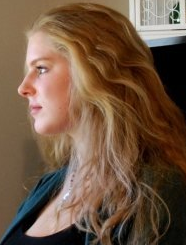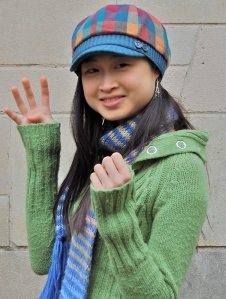
In honor of Halloween this weekend, we thought we’d answer this QOTW about treats from Angela!
After following a lot of writers on twitter, I realized that we all have something called “writer`s munches”. For example, mine is chocolate. I can`t write a single word without a bite of my chocolate-y goodness.
What food or drink do you like to snack on when you write? I think this is also a good time to exchange recipes, lol.
~~~
 Cheesy popcorn is my snack of choice. I may or may not have eaten an entire bag during one rather furious writing session a week ago… It’s like I eat it without thinking, and when I finish a chapter, the bag is gone. I’m convinced a ghost came and ate half the bag when I wasn’t looking.
Cheesy popcorn is my snack of choice. I may or may not have eaten an entire bag during one rather furious writing session a week ago… It’s like I eat it without thinking, and when I finish a chapter, the bag is gone. I’m convinced a ghost came and ate half the bag when I wasn’t looking.
As for my drink of choice, I firmly believe apple cider makes any writing session a million times better.
–The Writer and Former Intern Currently Querying
~~~
 CHOCOLATE COVERED RAISINS. They’re just so damn good. I don’t like raisins alone or raisins in bread or anything but when they’re covered in chocolate, it’s just the perfect mix of sweet and tangy and fruity and YUM. If that’s not available, any kind of small finger food that doesn’t leave your hands greasy/sticky/grimy is awesome because I don’t have to worry about picking up utensils. It’s faster to use fingers, pop it in your mouth, and continue writing :P.
CHOCOLATE COVERED RAISINS. They’re just so damn good. I don’t like raisins alone or raisins in bread or anything but when they’re covered in chocolate, it’s just the perfect mix of sweet and tangy and fruity and YUM. If that’s not available, any kind of small finger food that doesn’t leave your hands greasy/sticky/grimy is awesome because I don’t have to worry about picking up utensils. It’s faster to use fingers, pop it in your mouth, and continue writing :P.
Drink of choice is just water. I always have water on my desk.
–The Writer Editing Her First Novel!
~~~
 Coffee first and foremost. Then, I tend to eat cookies… Any kind will do, but usually I end up with something called “Karamellgebäck” (caramel cookies). They’re pretty AMAZING, and you can’t eat just one. Plus, they go perfectly with coffee — an amazing taste bud combination.
Coffee first and foremost. Then, I tend to eat cookies… Any kind will do, but usually I end up with something called “Karamellgebäck” (caramel cookies). They’re pretty AMAZING, and you can’t eat just one. Plus, they go perfectly with coffee — an amazing taste bud combination.
Next, I go crazy over candy — specifically sour gummy bears. Germans are known for their amazing gummy bears, and my particular favorites are soooooo delicious and sooooo addictive. Strangely, though, this one brand is really hard to find. I can only ever get them at this one Bauhaus (like a Home Depot), and then only when they happen to have them in stock. Needless to say, when they are available, I LOAD UP. I look like an idiot — going to a Bauhaus only to buy ten giant packages of gummy bears. But my cravings shall not be denied!
I’m actually giving away all my favorite munchies for my giveaway extravaganza. What a crazy random happenstance!
–The Newest LTWF Contributor!
~~~
 I like rice crackers, sometimes and tea. Lots and lots of tea (I’m very seriously addicted to tea, I drink like six-seven cups a day and if I try to cut back and drink four I get the worst headaches. Withdrawal symptoms from tea, I kid you not). I’m also a fan of chocolate. But I don’t really eat very much when I write — usually I just forget to eat because I get all caught up in the story.
I like rice crackers, sometimes and tea. Lots and lots of tea (I’m very seriously addicted to tea, I drink like six-seven cups a day and if I try to cut back and drink four I get the worst headaches. Withdrawal symptoms from tea, I kid you not). I’m also a fan of chocolate. But I don’t really eat very much when I write — usually I just forget to eat because I get all caught up in the story.
–The Other Writer on Submissions
~~~
 I don’t have a go-to snack… I think I usually take food breaks because the part I’m writing is tough and I just don’t want to deal with it. Eating is an avoidance tactic, lol. I usually go for leftovers, but something sweet definitely has more appeal. I’ll eat energy bars, little ice cream cups, potato chips… anything bad for me, really. And let’s just say that we have way less Halloween candy for trick-or-treaters today than we had when I first bought it (note to self: NEVER by Halloween candy until the day before!)
I don’t have a go-to snack… I think I usually take food breaks because the part I’m writing is tough and I just don’t want to deal with it. Eating is an avoidance tactic, lol. I usually go for leftovers, but something sweet definitely has more appeal. I’ll eat energy bars, little ice cream cups, potato chips… anything bad for me, really. And let’s just say that we have way less Halloween candy for trick-or-treaters today than we had when I first bought it (note to self: NEVER by Halloween candy until the day before!)
Does anyone else like to munch but also resent it cause then your hands get icky and you have to wipe them on something before you type again? I wish I could eat and type at the same time, lol.
-The Writer Converting Three Books Into One!
~~~
 It’s a toss up between brownies, or toast with Nutella. Actually, since brownies require time to actually make (time I don’t really have these days), I’d say it’s more often than not toast and Nutella. I swear I have a serious addiction to that stuff. I sometimes even eat spoonfuls of Nutella straight from the jar! I mean… bread and choclate/hazelnut spread? HEAVEN!
It’s a toss up between brownies, or toast with Nutella. Actually, since brownies require time to actually make (time I don’t really have these days), I’d say it’s more often than not toast and Nutella. I swear I have a serious addiction to that stuff. I sometimes even eat spoonfuls of Nutella straight from the jar! I mean… bread and choclate/hazelnut spread? HEAVEN!
–The Writer in the Publishing Industry Working On Her First Novel!
~~~
 I really don’t snack while I write, because, like Savannah, I use snacking as an excuse for a “get-up-from-the-laptop” break. I love gummy bears, and at Easter, I could (and practically do) live on marshmallow Peeps. Susan’s story about going to the store just to buy massive amounts of sweets hits home with me. At Easter, I’ll get in the check-out lane with a cart FULL of Peeps. (They last for months, but you have a very short window in which to stock up.) I usually try to make some fraudulent chit-chat with my husband to deceive the cashier – something like, “Do you think this will be enough Peeps for all the kids at the party?” but he always tells the cashier that I’m full of crap and they’re all for me! Ah, well, I couldn’t be too embarrassed; I just confessed the truth of my addiction on the internet!
I really don’t snack while I write, because, like Savannah, I use snacking as an excuse for a “get-up-from-the-laptop” break. I love gummy bears, and at Easter, I could (and practically do) live on marshmallow Peeps. Susan’s story about going to the store just to buy massive amounts of sweets hits home with me. At Easter, I’ll get in the check-out lane with a cart FULL of Peeps. (They last for months, but you have a very short window in which to stock up.) I usually try to make some fraudulent chit-chat with my husband to deceive the cashier – something like, “Do you think this will be enough Peeps for all the kids at the party?” but he always tells the cashier that I’m full of crap and they’re all for me! Ah, well, I couldn’t be too embarrassed; I just confessed the truth of my addiction on the internet!
Beverage of choice? Easy – Diet Coke with Lime. 🙂
–The Writer on Submissions!
~~~
 I require Diet Coke. Beyond that, I love gummy bears or baked sour cream and cheddar chips. Mmmmmm.
I require Diet Coke. Beyond that, I love gummy bears or baked sour cream and cheddar chips. Mmmmmm.
I also love skittles.
–The Writer and Literary Agent
~~~
 I definitely need some form of caffeinated beverage, preferably coffee, diet coke, or diet mountain dew. But if it’s late enough in the day (past 6), I need a pot of caffeine-free tea sitting on my desk. As for food…I’m pretty much prone to eating everything from dumplings to cheetos, though I DO have a soft spot for ravioli…
I definitely need some form of caffeinated beverage, preferably coffee, diet coke, or diet mountain dew. But if it’s late enough in the day (past 6), I need a pot of caffeine-free tea sitting on my desk. As for food…I’m pretty much prone to eating everything from dumplings to cheetos, though I DO have a soft spot for ravioli…
–The Writer With Her First Book Deal!
~~~

Like Vee I need tea, lots and lots of hot tea, or in the middle of summer, good, southern sweet tea. I don’t tend to eat when I’m writing because I forget, and food just gets in the way, it makes my hands sticky and crumbs get on the keyboard. A nice big mug is much easier to deal with!
– The Other Writer Currently Querying
~~~
 Add me to the list of people who can’t eat while they’re writing. I can’t really do anything while writing. I have to completely be in the zone, which is hard enough with my gnat-sized attention span. However, I eat all the time while staring at my manuscript and willing it to write itself 🙂 Munchies of choice are cereals–anything that’s satisfyingly crunchy and at least a little sweet. Right now, I’ve got a bit of an obsession with Raisin Bran Crunch. I don’t know what’s up with the raisin hate, Billy–raisins are awesome! And the cereal is really good. Really. You should try it. Just don’t blame me once the addiction takes hold.
Add me to the list of people who can’t eat while they’re writing. I can’t really do anything while writing. I have to completely be in the zone, which is hard enough with my gnat-sized attention span. However, I eat all the time while staring at my manuscript and willing it to write itself 🙂 Munchies of choice are cereals–anything that’s satisfyingly crunchy and at least a little sweet. Right now, I’ve got a bit of an obsession with Raisin Bran Crunch. I don’t know what’s up with the raisin hate, Billy–raisins are awesome! And the cereal is really good. Really. You should try it. Just don’t blame me once the addiction takes hold.
-The Writer Who Just Signed With an Agent!
~~~
What are YOUR go-to writer munchy foods?
Tags: Question of the Week






 Coffee first and foremost. Then, I tend to eat cookies… Any kind will do, but usually I end up with something called “Karamellgebäck” (caramel cookies). They’re pretty AMAZING, and you can’t eat just one. Plus, they go perfectly with coffee — an amazing taste bud combination.
Coffee first and foremost. Then, I tend to eat cookies… Any kind will do, but usually I end up with something called “Karamellgebäck” (caramel cookies). They’re pretty AMAZING, and you can’t eat just one. Plus, they go perfectly with coffee — an amazing taste bud combination.










 What do you think of when you hear the term graphic novel? I’m willing to bet that images of Spiderman, Batman, and Wonder Woman pop in to your head. But graphic novels aren’t just for superheroes and villains anymore. The audience for graphic novels has been expanding rapidly over the past few years. These days you can find graphic novels about
What do you think of when you hear the term graphic novel? I’m willing to bet that images of Spiderman, Batman, and Wonder Woman pop in to your head. But graphic novels aren’t just for superheroes and villains anymore. The audience for graphic novels has been expanding rapidly over the past few years. These days you can find graphic novels about 



 LTWF Facebook
LTWF Facebook LTWF Twitter
LTWF Twitter